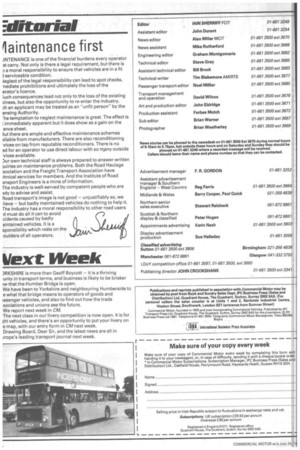laintenance first
Page 2

If you've noticed an error in this article please click here to report it so we can fix it.
,INTENANCE is one of the financial burdens every operator St carry. Not only is there a legal requirement, but there is 3 a moral responsibility to ensure that vehicles are in a fit serviceable condition.
Jeglect of the legal responsibility can lead to spot checks, nediate prohibitions and ultimately the loss of the erator's licence.
;uch consequences lead not only to the loss of the existing 3iness, but also the opportunity to re-enter the industry. 7,h an applicant may be treated as an "unfit person" by the ensing Authority.
The temptation to neglect maintenance is great. The effect is : immediately apparent but it does show as a gain on the ance sheet.
3ut there are ample and effective maintenance schemes 3ilable from manufacturers. There are also reconditioning vices on tap from reputable reconditioners. There is no ad for an operator to use direct labour with so m_arly outside vices available.
Jur own technical staff is always prepared to answer written luiries on maintenance problems. Both the Road Haulage sociation and the Freight Transport Association have hnical services for members. And the Institute of Road 3nsport Engineers is a mine of information.
The industry is well-served by competent people who are 3dy to advise and assist.
Road transport's image is not good — unjustifiably so, we lieve — but badly maintained vehicles do nothing to help it. The industry has a moral responsibility to other road users d must do all it can to avoid cidents caused by badly aintained vehicles. It is a sponsibility which rests on the oulders of all operators.








































